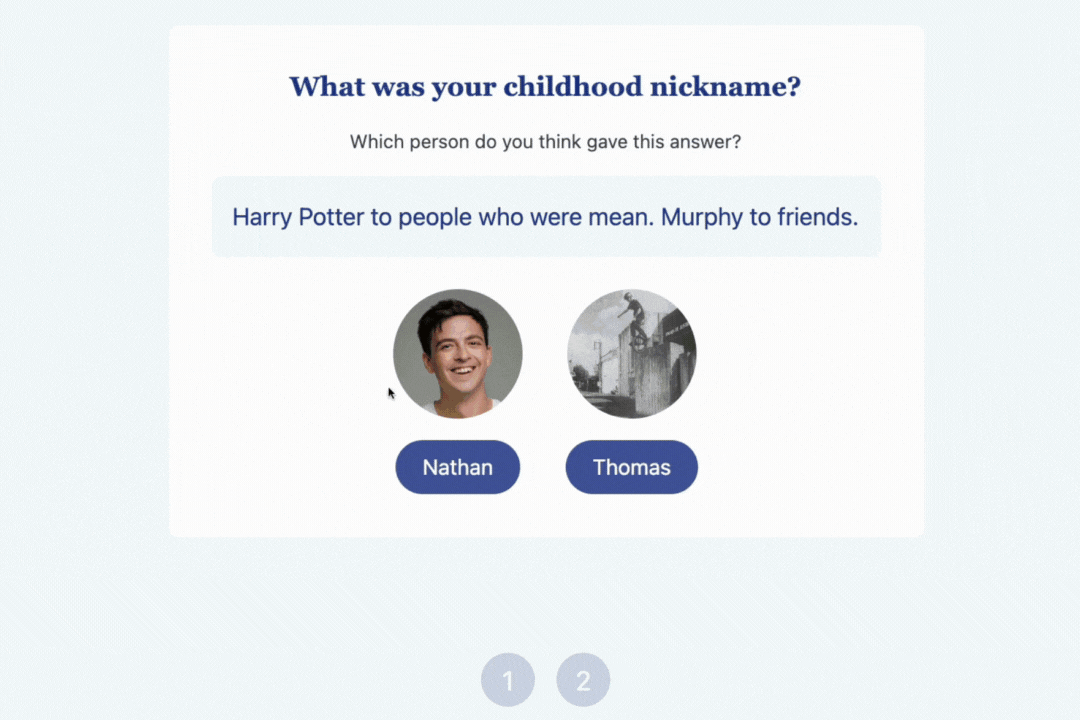Looking for the perfect icebreaker? We've got you! An icebreaker game is something done or said to relax the formal atmosphere of a situation. It's a fun and imaginative way to improve team bonding and relationships.
Key Takeaways
- Icebreaker games help your team get loose and acquainted before events, meetings, or team building activities. They take very little time to complete, often no more than a few minutes to an hour maximum.
- We've listed down up to 33 of our favorite icebreaker games. We've tried them and some of our customers (many of them being masters at team culture and team building) have recommended them to us.
- Each icebreaker game listed comes with full instructions, so you should find it relatively easy to implement any of the ideas!
We’ve put together the ultimate free guide to icebreaker games. It’s a series of beautiful chapters with 33 ideas for anyone to try.
If you're looking for great icebreaker ideas for your team members, then this is the ultimate guide for you. In this guide, we're going to show you a range of icebreaker activities that will improve company culture and help people in small businesses trust one another.
| Icebreaker | Participants | Duration | Difficulty |
|---|---|---|---|
| Quizbreaker | 5 - 250 players | 5 minutes | Easy |
| Trivia Games | 5 - 100 players | 10 minutes | Easy |
| Bucket List | 5 - 15 players | 10 minutes | Easy |
| Portrait Gallery | 2 - 40 players | 30 - 60 minutes | Medium |
| Back to Back Drawing | 4 - 20 players | 5 minutes | Medium |
| Lego Metaphors | 5 - 10 players | 7 - 10 minutes | Medium |
| Ride 'Em Cowboy | 20 - 200 players | 10 - 30 minutes | High |
| Repeat Performances | 60 - 500 players | 3 - 5 minutes | Medium |
| One Liners | 8 - 20 players | 3 -4 minutes | Easy |
| Poetry In Motion | 20 - 60 players | 5 - 10 minutes | High |
The aim of all our icebreaker games is that they are fun and only require a small amount of time.
If your team is working remotely at the moment then you should check out our guide on virtual team building activities for remote teams. In there you'll find 100 ideas with instructions that you can try with your new remote team.
Why Do Teams Use Icebreakers?
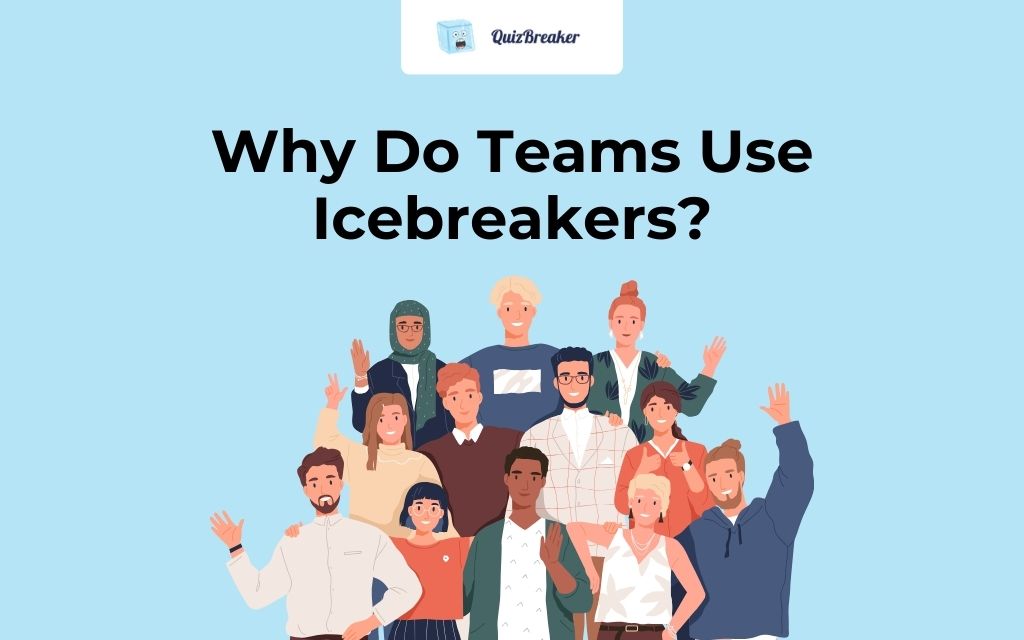
Traditionally, humans have always lived in small and stable societies. However, the ever developing culture of the workplace means that societies, and human interactions, are becoming larger and far more dynamic.
With the change of society, comes the constant formation of groups. However, joining a new group, such as a work team, may often feel unnatural, uneasy and prompt excessive worries about how to interact and behave with our new team members.
Let’s face it, we’ve all experienced those first day nerves. Wouldn’t it be handy if there was a quick and fun way to resolve our ‘newbie anxiety’?
Well, ice breaking activities, designed to be short and sweet ways to break down the barriers between employees to help them to get to know and understand each other, are just the solution.
When used properly, this initial breaking of the ice will leave teams content, enthused and trusting; promoting successful and strong teams.
Benefits Of Using Good Icebreakers
.jpg)
Like all team-based activities, there are many advantages of using virtual icebreakers to overcome the initial awkwardness that naturally happens when a group of new people are put together. Below are a number of ways in which icebreaker games can benefit your team.
1. Encourages employees to interact and communicate with each other
According to a report by TinyPulse, the vast majority of workers feel detached from their coworkers, with only 24% of people reporting that they feel connected to their peers. Which in turn, leads to employees feeling disengaged, being less productive, and more prone to work-related stress and burnout.
While it’s unlikely that they’ll become best friends overnight, icebreaker games open the door for people to get to know one another and start building that all-important sense of community within the workplace. Research has shown that even simple icebreakers that ask participants to talk about themselves were incredibly powerful in developing trust and likability amongst people, even if they only ever interact online.
Furthermore, icebreakers drastically reduce the amount of time it would normally take for people to get comfortable collaborating with one another.
2. Encourages employees to interact without the restrictions of authorities or roles
Whether you’re introducing a new hire to the company or leading an important meeting, icebreakers give people an idea of what to expect when moving forward and allow the barriers of organisational hierarchy to be broken down.
For example, when running a meeting where you want to encourage everyone to actively participate and contribute new ideas, ice breakers can be used at the start of the session to give everyone the chance to speak their mind without worrying about hierarchy.
3. When used on new employees, ice breaking can improve the training process
A lot of the focus of this chapter will be on using icebreakers for teams that have been formed for a while and to be used during team meetings. However, many people forget that icebreaker questions can be used on new teams.
In fact, research has shown that when used early on in training, icebreakers can improve the training process because they improve communication and transparency throughout teams.
4. Creates better teams
Due to all the above-mentioned things, the use of icebreaker exercises eventually creates better teams. For instance, the Japanese place a massive emphasis on team building activities and ice breaking, and it is believed that this has led to the success of their culture through constant communication and exchange.
Research done by [PulseMate] has also found that teams that regularly participate in quick connection activities help them form closer bonds.
Sit tight and prepare to smash through the ice like an overweight polar bear. Here are some of the best icebreaker games and activities for teams. We'll break them down into categories, namely:
-
Top-Pick Icebreaker Games (because they're so fun!)
-
Creative Icebreaker Games
-
Team Bonding Icebreaker Games
-
Memory and Observation Icebreaker Games
-
Strategy Icebreaker Games
-
Personal Sharing Icebreaker Games
Let's dive in.
Top-Pick Icebreaker Games
These games are handpicked for their ease of setup, universal appeal, and proven track record in breaking down barriers. Perfect for kicking off meetings, workshops, or any team event, these activities pave the way for open dialogue, mutual respect, and a relaxed environment.
1. QuizBreaker
Objective: discover new things about each other in online virtual meetings
Participants: 5 to 250
Duration: 5 minutes a week
Difficulty: Easy
Materials: None required
QuizBreaker is a virtual online icebreaker game that we invented in order to help virtual teams get to know each other a little bit better each week.
Instructions
Set up a free trial account of QuizBreaker and invite your team to join it. They'll be prompted to answer a bunch of icebreaker questions which you have the ability to customize.
Schedule your first icebreaker quiz to get sent out and enjoy the fun that comes next!
In case you need to beef up your list of icebrekaer questions, try out our free random icebreaker generator.
2. Trivia Games
Objective: learn new things in a light hearted way
Participants: 5 to 100 players
Duration: 10 minutes
Difficulty: Easy
Materials: None required
We love this classic game because it encourages employees to publicly speak, but it doesn't involve speaking about themselves; meaning it is well suited to quieter or more introverted employees.
What would you pick, the fact that the unicorn is the national animal of Scotland (ridiculous, I know) or that a crocodile cannot stick its tongue out?
Instructions
For many people, their aversion about speaking in public isn’t necessarily with talking in public but talking about themselves. A way to break the ice on that is to ask them to share a random piece of trivia that they know.
This is an effective icebreaker because everyone has that one random fact that they somehow know and it takes a lot of the pressure off of trying to think of interesting facts about themselves.
It’s an easy way to get everyone involved and gives people a chance to say something without feeling too self-conscious.
To be honest, this icebreaker is the simplest of them all. Just go around the room and get participants to quickly say a random fact. To make it more engaging, you could ask employees to repeat their favourite fact at the end of the game.
You can also use a tool like TriviaNerd to better facilitate these random trivia ice breakers. Feel free to gamify it too and introduce some friendly competition into the mix.
3. Bucket List
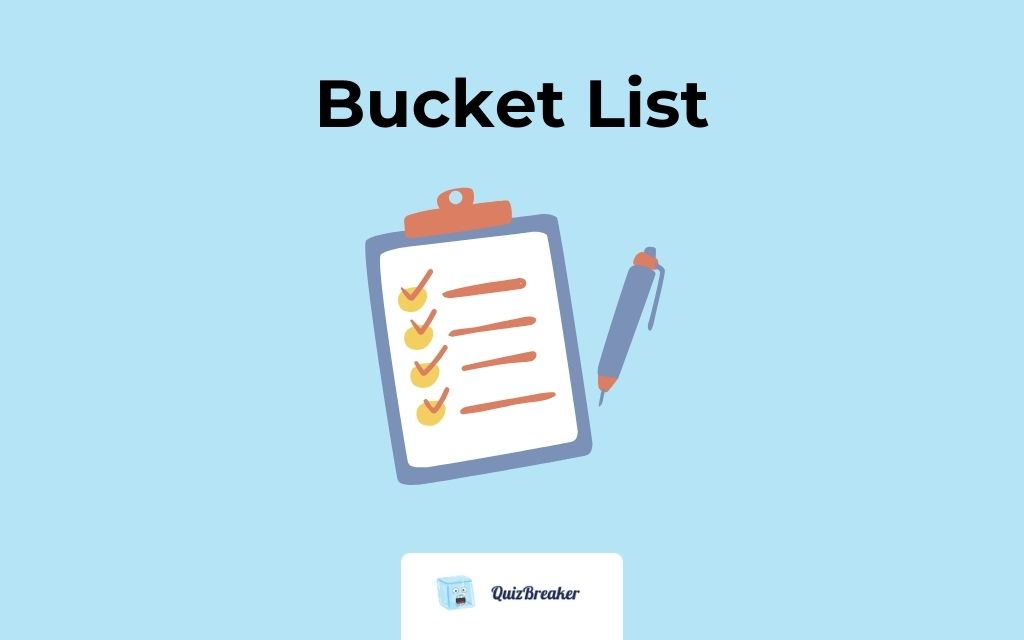
Objective: Get everyone to share with each other what is on their bucket list
Participants: 5 to 15 people
Duration: 10 minutes
Difficulty: Easy
Materials: None
Despite sometimes feeling shy, to begin with, we can all admit that we love talking about ourselves.
A simple way to get new recruits to talk about themselves is with this classic icebreaker.
It can give incredible insight into what your team's motivation and driving factors are.
Instructions
Again, the instructions are super simple.
Get each team member to express what five things are on their bucket list. Depending on their answer, this also gives you ample opportunity to provide value to them beyond your professional relationship.
For example, if you find out that one of your new client’s items on their bucket list is about travelling, then you can send them some information about a country they’re interested in visiting.
Creative Icebreaker Games
4. Portrait Gallery
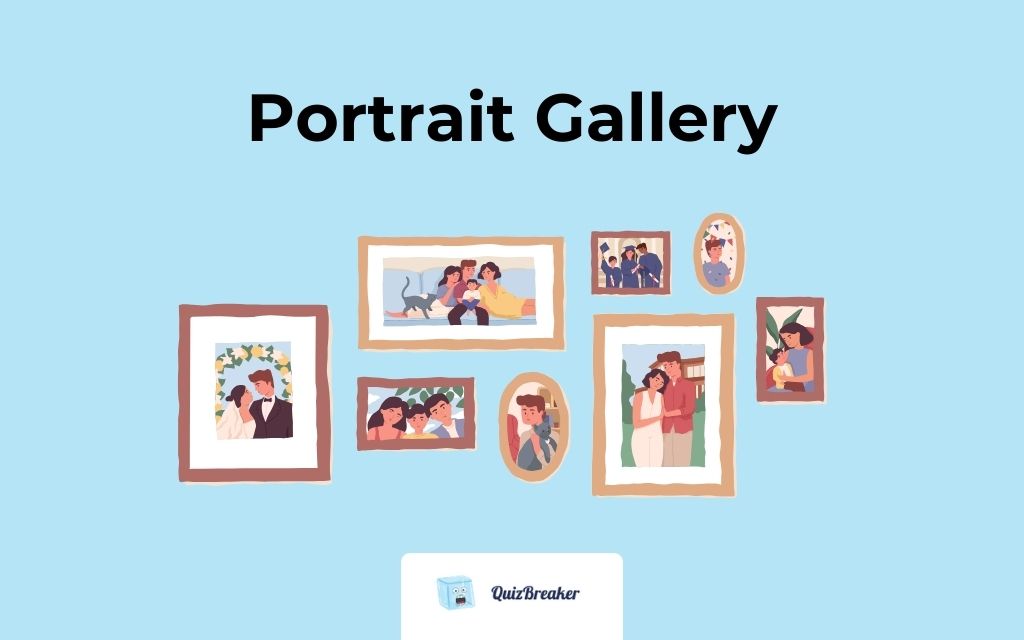
Objective: To get participants to draw each other
Participants: 2 to 40
Duration: 30 to 60 minutes
Difficulty: Medium
Materials: A sheet of paper and a pen per participant
This ice breaker is guaranteed to create a laugh and get participants to interact with each other. It’ll get everyone’s creativity flowing - but just make sure people don’t offend each other by drawing terrible pictures!
Instructions
-
Put participants in pairs and give each person a piece of paper and a selection of pen/pencil colours.
-
Give participants 20 minutes to draw each other.
-
At the end, collect the portraits and put them up on the office or staff room wall for a bit of a giggle.
5. Back to Back Drawing
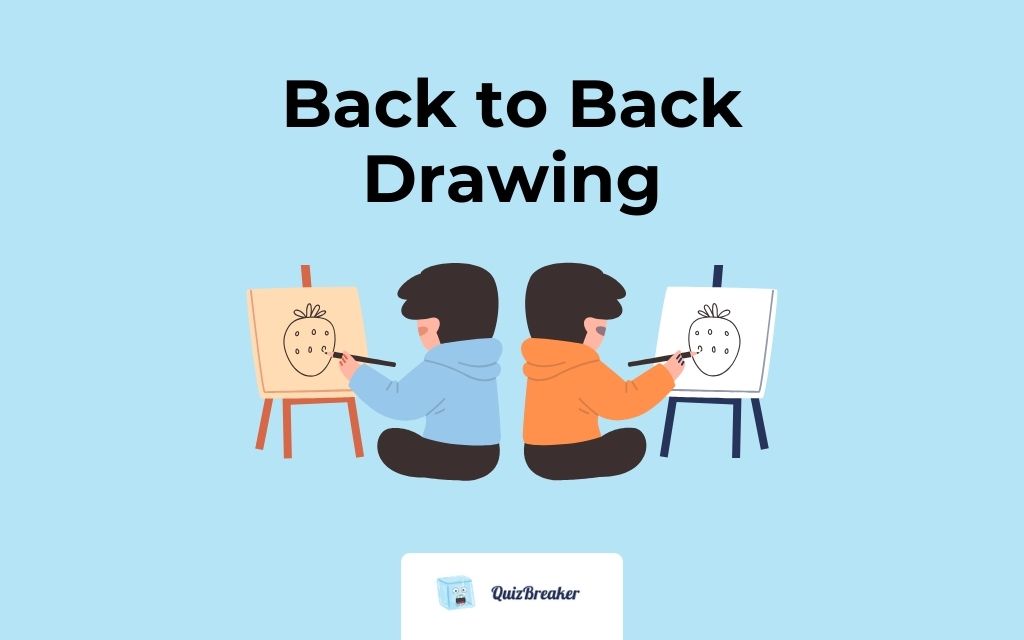
Objective: To get participants to speak to each other and enhance creativity
Participants: 4 to 20
Duration: 5 minutes
Difficulty: Medium
Materials: A list of objects (e.g., a cat, a pen, a car) and a piece of paper and pen per pair
We love this game because it is a fun and effective way of developing verbal communication.
This ice breaker is also creative, which is important as recent research has found that individual creativity within a team improves the quality of team decision making processes.
This means that teams high in creativity are more effective and have a better team climate.
So, be sure to use this ice breaker to enhance creativity in your team!
Instructions
-
Get participants to sit facing away from each other.
-
Give one participant the piece of paper that has an object or phrase written on it. This participant should describe this to the other person without saying directly what they see/without using words the give it away.
-
The other pair then has to draw a picture of what they think it could be.
6. LEGO Metaphors
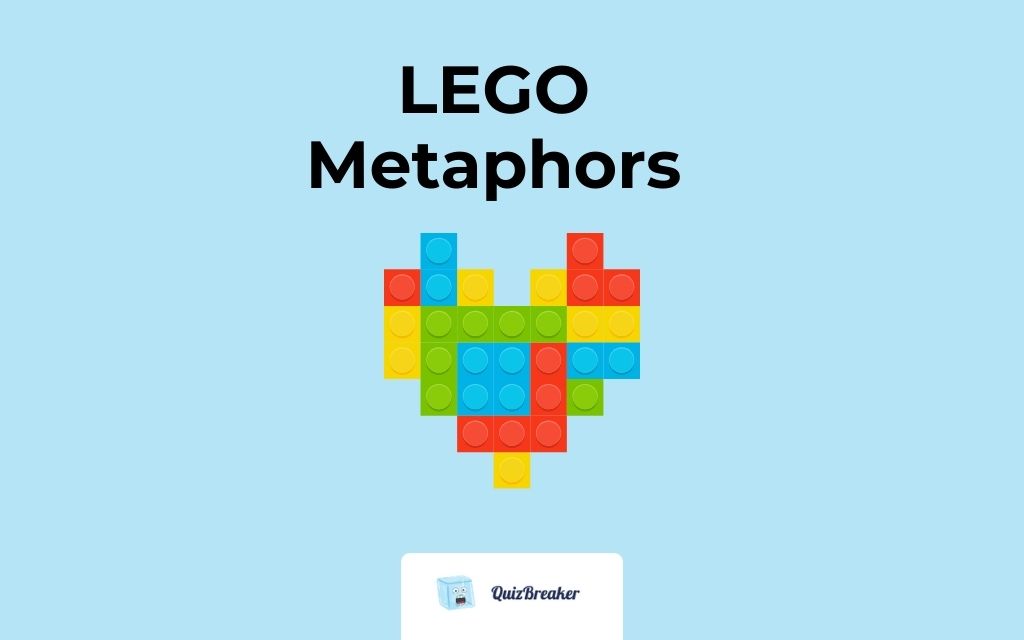
Objective: Everyone creates objects from lego that are related to the meeting
Participants: 5 to 10
Duration: 7 to 10 minutes
Difficulty: Medium
Materials: Lego bricks (around 5 to 10 per person)
We love this ice breaker idea because it doesn’t sacrifice fun and appeals to everyone’s inner child - who doesn't miss playing with Lego?
This ice breaker also promotes creativity, so it is great to use at the start of a meeting as a quick way to get everyone's creative juices flowing.
Instructions
-
Give each team member their lego bricks and tell them the main theme for the meeting that is about to commence.
-
Get everyone to build something with the lego that relates to the topic of the meeting.
-
After around 3 to 5 minutes, give everyone 30 seconds to explain to the rest of the group what they have built and how it related to the meeting.
7. Ride Em' Cowboy
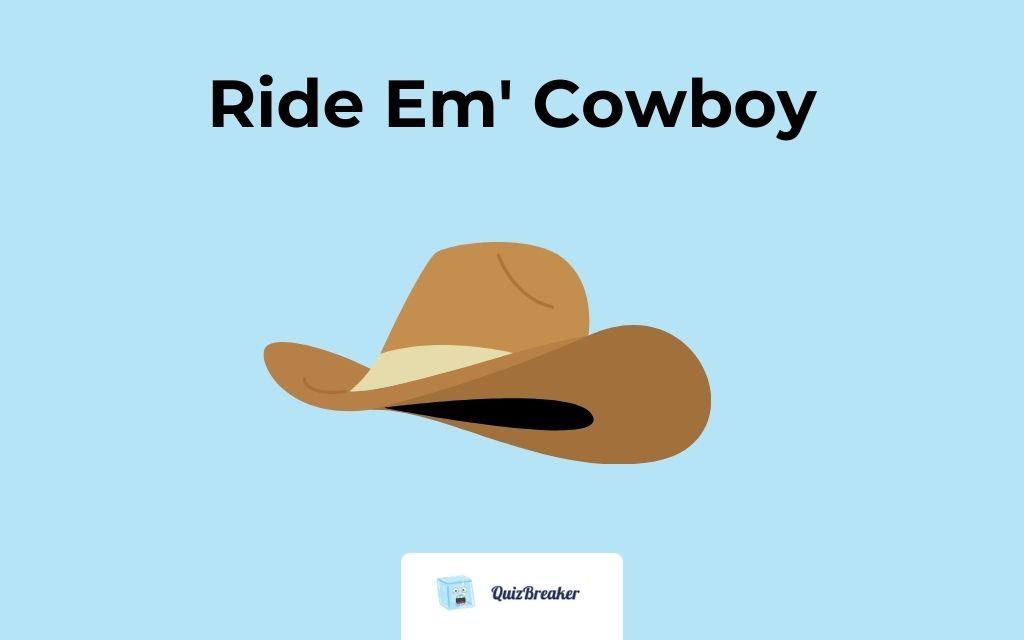
Participants: 20 to 200
Duration: 10 to 30 minutes
Difficulty: High
Materials: Lively music, cards… cards will include activities such as bull riding, calf roping, bareback riding, hog tying etc (cowboy activities).
We fell in love with this activity because it is high-energy and gives each group a chance to entertain the rest of the participants.
It’s great for bringing everyone out of their shell, but we do recommend using it at the end of a meeting as participants will feel more comfortable performing once they have spent some time together.
Instructions
-
Participants should be organised into groups of 5 to 20 and each group should be given a card for each person
-
Each group has 5 minutes to develop and practice the events shown on the cards before performing them to the rest of the cohort
-
Each group takes it in turn to perform with movement, sound, and dialogue to make their performance engaging and memorable
-
After all groups have performed, participants can vote on categories such as 'Most Creative Interpretation', 'Best Performance', or 'Most Entertaining Skit'
8. Repeat Performances
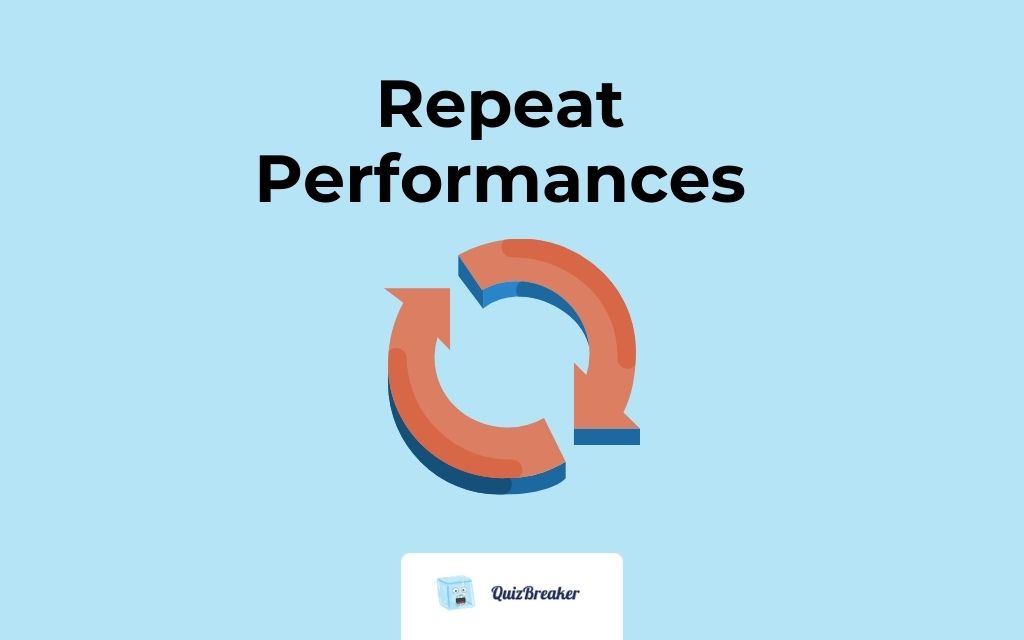
Participants: 60 to 500
Duration: 3 to 5 minutes
Difficulty: Medium
Materials: None
We like this ice breaker activity because essentially it kills two birds with one stone. You get to give a motivating and inspiring speech to your employees, whilst also introducing a fun and exciting ice breaker to the meeting.
Research has found time and time again, that a good speech improves employees empowerment and motivation - which is why this icebreaker is so high up our list.
Instructions
-
Before starting the game, you should decide on two specific words or phrases that you would like participants to walk away from the speech remembering.
-
Explain to your employees that you would like them to participate in your speech and they will do this by shouting out certain words when you point with your right hand and certain words when you point with your left hand (e.g., chose the words “yes” or “no” and ask questions periodically throughout the speech for the audience to respond to)
-
Before starting, do a practice round in which you point your left or right hand and get them to give answers.
9. One Liners
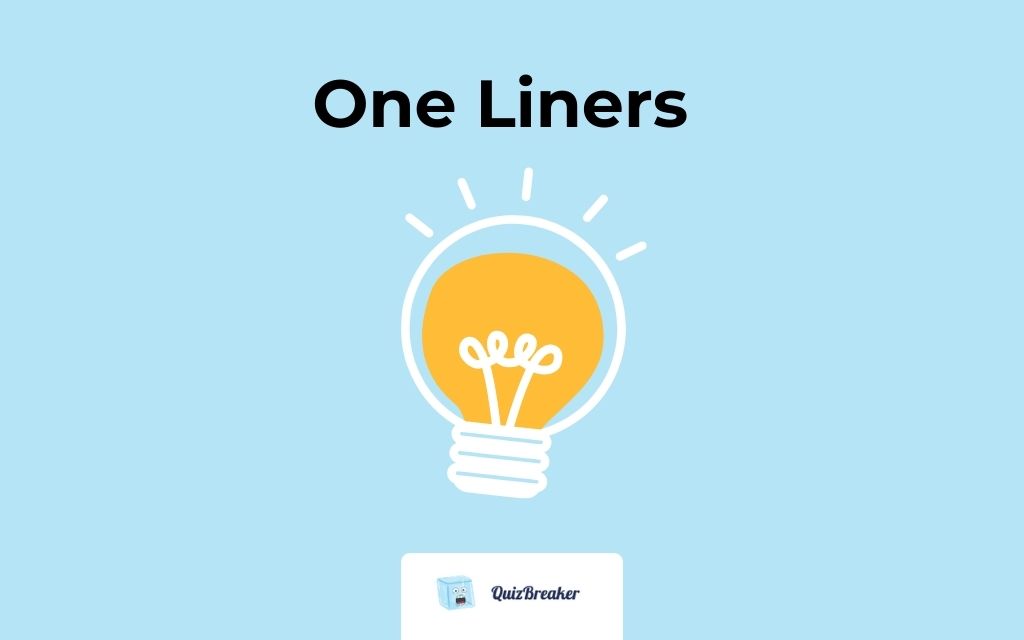
Participants: 8 to 20
Duration: 3 to 4 minutes
Difficulty: Easy
Materials: None
We love this icebreaker game because it requires some mental stimulation; we suggest using it at the start of a meeting to get your employee’s awake and on the ball.
Instructions
-
Organise participants into pairs
-
Each pair must come up with a least one famous line from a book, movie or famous person that no one else will think of
-
After a minute or so, each pair must say their line to the rest of the group and the other pairs have 20 seconds to write down where they think the quote has come from
-
Once the game is done, determine which pair has the most correct answers. To keep the game exciting, we suggest offering alcoholic or edible prizes to the winning pair!
10. Poetry In Motion

Participants: 20 to 60
Duration: 5 to 10 minutes
Difficulty: High
Materials: Three to six poems (one per group) that would lend themselves to movement.
We love this activity because it gets people up and moving about and incorporates poetry - let's face it, we could all do with a little more appreciation for the art of poetry.
Instructions
-
Organise participants into groups of 8 to 10
-
Give a poem to each group and explain that each piece of poetry has its own rhythm
-
Tell participants they will have 5 minutes to decide and practice movements that correspond to the reading of the poetry.
-
The employees then have to perform the poem and its movement to the rest of the group
Here is a suggested poem: The charge of the Light Brigade by Alfred, Lord Tennyson
Team Bonding Icebreaker Games
11. Pay It Forward
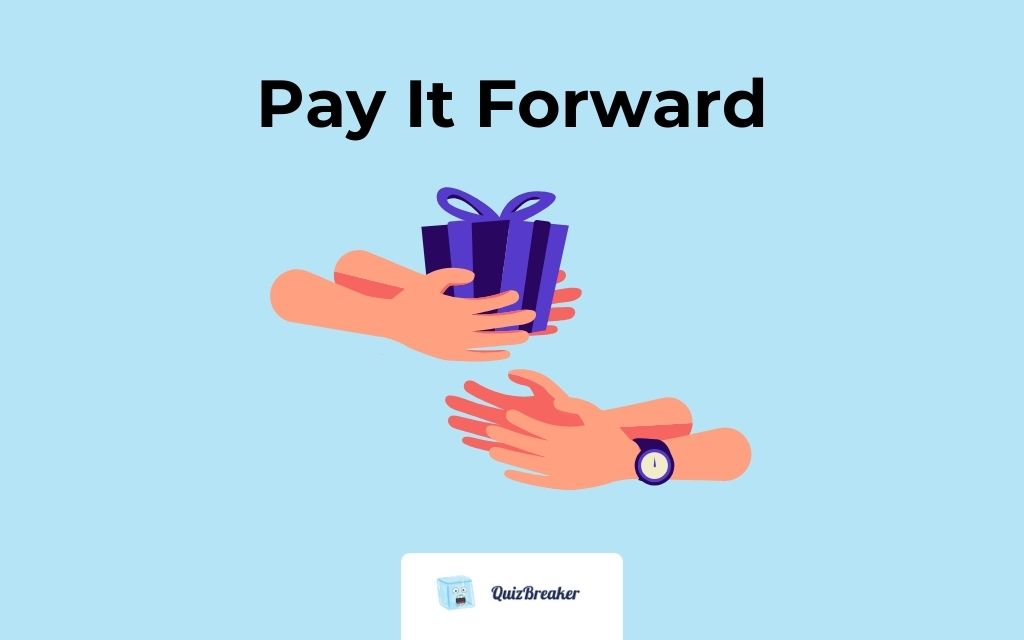
Objective: Everyone writes three positive attributes about a coworker, which highlights personal strengths and value
Participants: 5 to 50 people
Duration: 5 minutes
Difficulty: Easy
Materials: A piece of paper and pen per team member
Everyone loves feeling like they are appreciated and supported.
In fact, research has found that employees perform better when they feel valued by their employer and perceive higher organisational support.
So based on this scientific evidence, we can’t recommend highly enough using this icebreaker!
We feel that this ice breaker works best at the end of a meeting, as it ensures that everyone leaves on a positive note with a sense of accomplishment.
Overall, this activity encourages team members to practice gratitude, highlight personal strengths and makes people feel recognised and valued!
Instructions
-
Get everyone to sit in a circle.
-
Everyone must look at the person to their right and write three positive attributes about them. This can be simple things, like their attitude around the office, or how they help others out.
-
Personally, we feel this icebreaker is more effective when the answers are not read allowed. Simply get everyone to give the listed attributes to the person they wrote them about to finish the meeting on a high!
12. Baby Photos
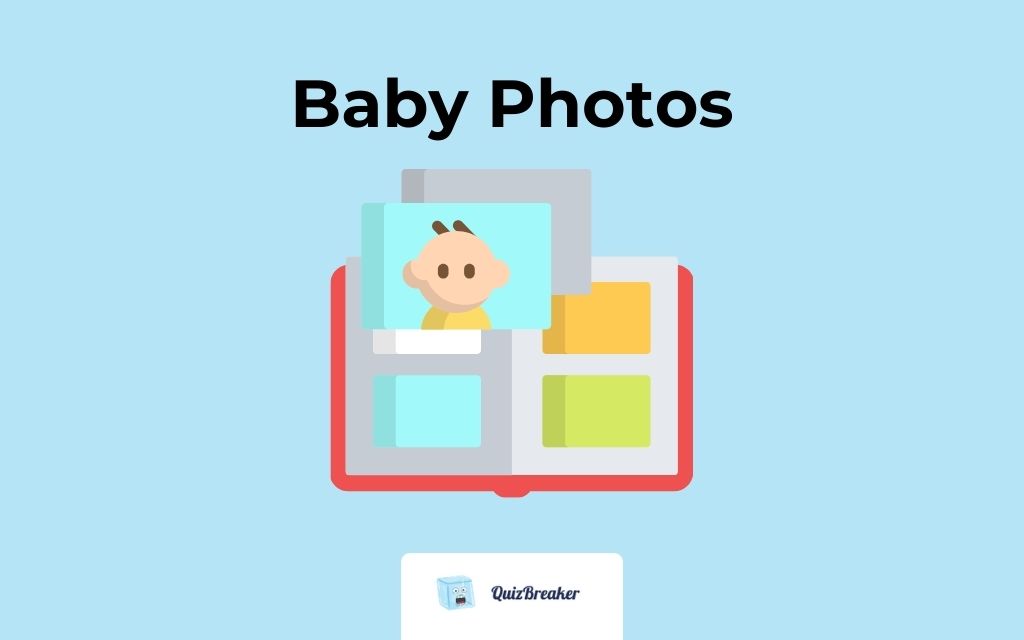
Objective: To get employees to guess which baby photo is of who
Participants: 10 to 30
Duration: 30 minutes
Difficulty: Medium
Materials: Everyone should bring in a baby photo
This is one of our favourite icebreaker games because it gets laughs and gets employees to feel closer to each other. Super super simple, and super super fun! It does take some preparation from your team though!
Instructions
-
Get everyone to bring in a baby photo of themselves, or get them to email you a copy.
-
Set the baby pictures out on a large table or wall (so everyone can clearly see them).
-
The aim is that everyone must guess which baby photo is who.
-
The winner is the person with the most correct answers - give them a prize, we suggest something edible!
13. Crazy Handshake
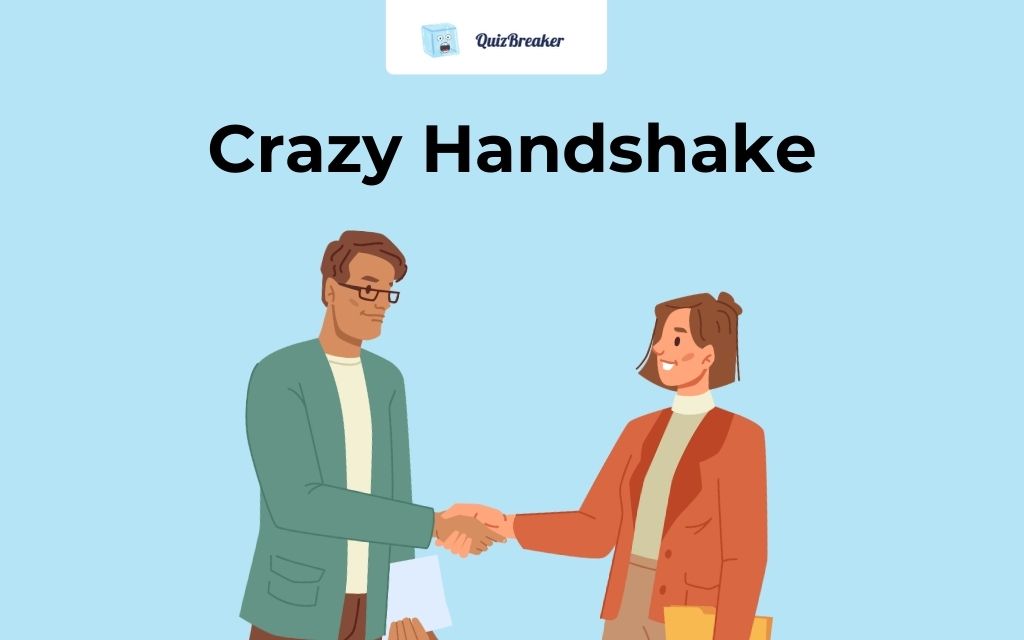
Objective: Get everyone to introduce themselves to each other in a creative way
Participants: 5+
Duration: 10 to 15 minutes
Difficulty: Easy
Materials: None
A similar version of this was shown in our other blog. We love this ice breaker because it easily allows team members to gently ease themselves into their new team, and brings out their creativity.
Instructions
-
Get participants into pairs.
-
Get each pair to create a creative handshake.
-
Split the pairs up and get each newly formed pair to teach each other the original handshake and create a new one.
-
Keep forming pairs for as long as you like.
14. Four Quadrants Activity
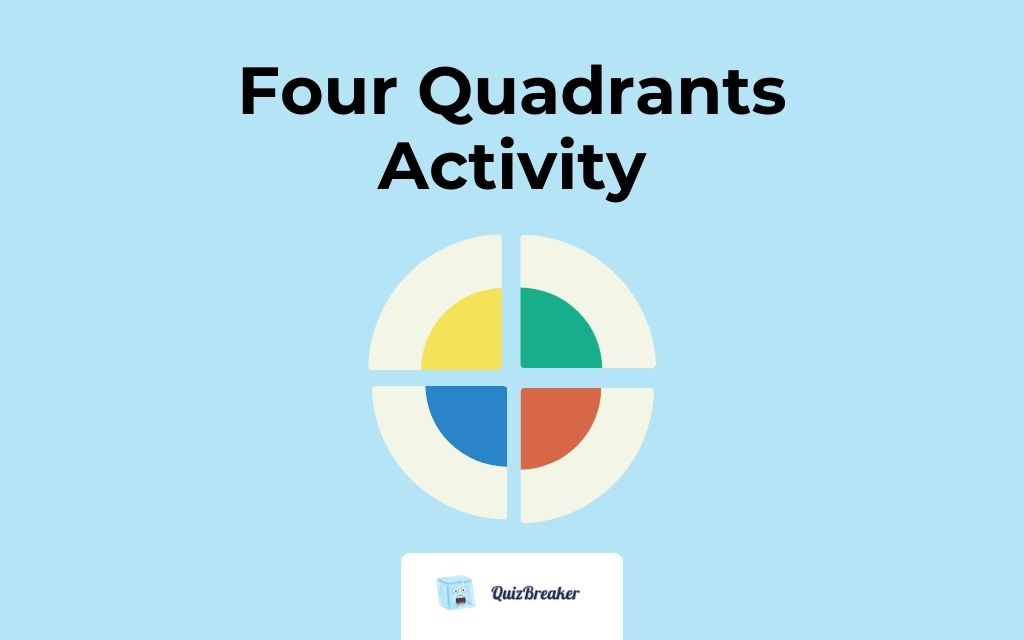
Objective: To create openness in the team and ensure that everyone is heard
Participants: 5 to 20
Duration: 5 to 10 minutes
Difficulty: Easy
Materials: A sheet of paper and a pen per participant
We love this because it's been tried and tested over and over again. And, guess what? … It works every time - a simple, but effective way to get to know each other.
Instructions
-
Have participants draw up a 2x2 grid on a piece of paper you give them.
-
Ask participants four questions.
-
These can be related to things such as: challenges they are facing, stressors at work, defining moments in their life, pride, fears etc.
-
Participants then draw the answers to the questions in each relevant quadrant.
-
Participants show each other their drawings and discuss their creations with each other.
15. Passions Tic Tac Toe
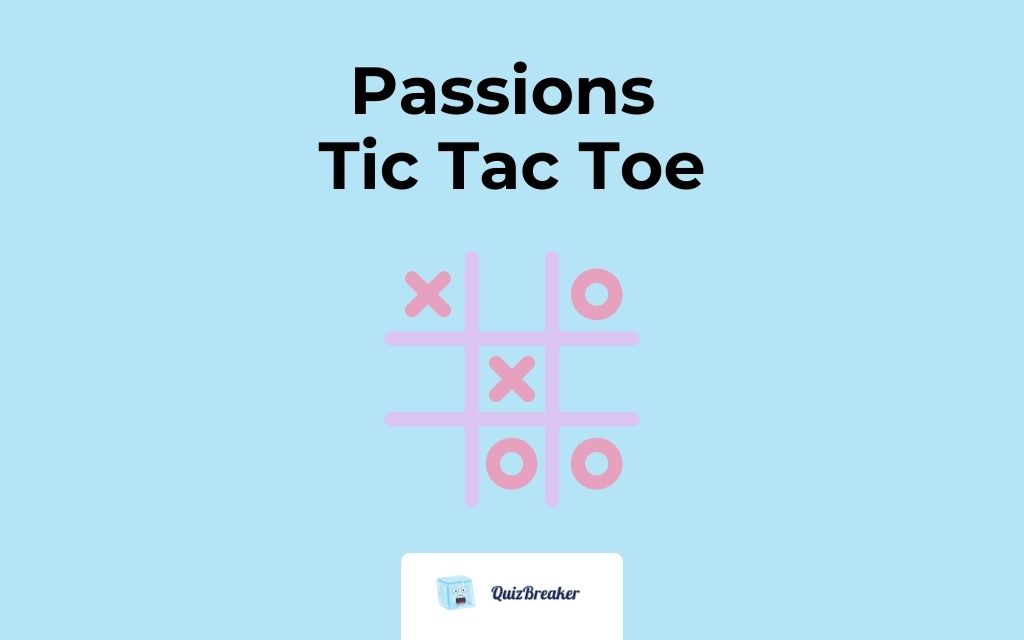
Objective: To help participants get to know each other at the beginning of an event, or to identify each employees values
Participants: 10+
Duration: 15 to 20 minutes
Difficulty: Medium
Materials: A homemade 3 x 3 grid for each participant
This sits as our top great idea for ice breakers because it helps employees connect on a more intense and deeper level.
We love it so much because research has consistently found that understanding an employee's core organisational values improves their performance and productivity; so we really think its an ice breaker that will get the most out of your team.
Instructions
-
Hand each participant the 3 x 3 grid that you’ll have made and ask them to fill in each block with a different personal passion.
-
Get your team to walk around the room and compare their grids with each other.
-
When employees find someone with the same passion as them, get them to sign each others grids.
-
The winner is the participant who manages to have signatures in three lines (either vertical, horizontal or diagonal). You can continue the game to have as many winners as you like.
16. All Aboard

Participants: 20 to 100
Duration: 5 to 8
Difficulty: Medium...requires some physical activity!
Materials: 2 balloons per person of varying colours (one colour for each group) and 1 permanent marker per group
We love this activity because it is great for any kind of large-group training session. It encourages team behaviours and creativity. It allows employees to have fun, be active and build trust. You can have smaller groups bond in breakout rooms as a way to have more quality interactions.
Instructions
-
Organise participants into groups of six to twenty and ask them to get into train formation
-
Distribute deflated balloons of varying colours around the room
-
Explain that each group is a passenger train and that they must pick up passengers (2 passengers per person)
-
The balloons become passengers when they are inflated and the employee creates a face on them with their permanent marker
-
The teams must move around the room in a train formation and gather the balloons - they must inflate the balloon and draw a face on it and they carry the balloon with them for the rest of the game. The train must stay still whilst being inflated
-
Essentially, the groups are competing to fill their trains with passengers (two passengers per person) - whichever train fills first, wins the race.
17. Double Take
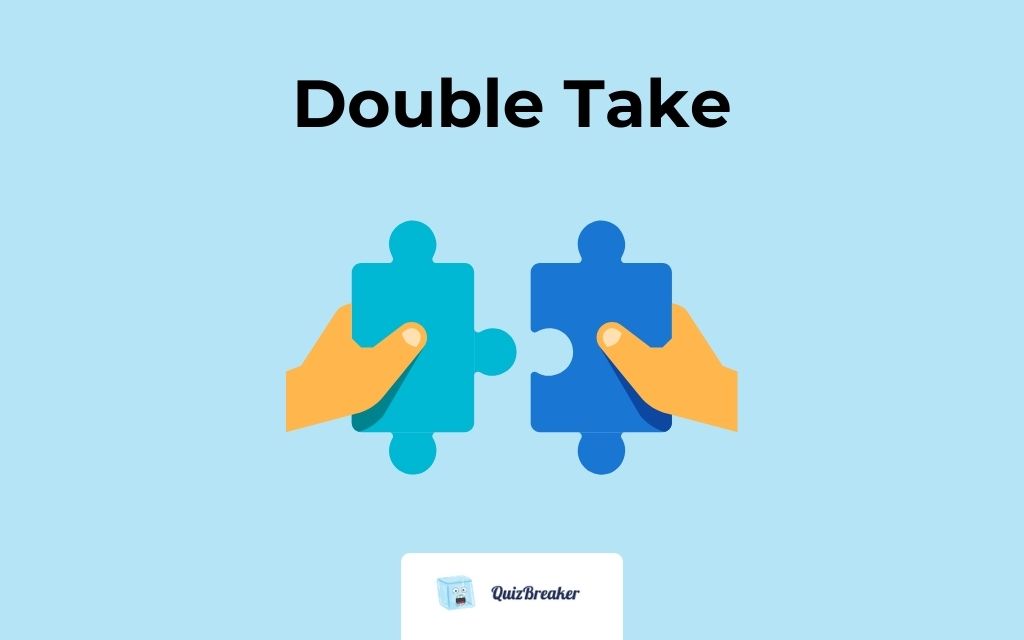
Participants: 20 to 500
Duration: 3 to 5 minutes
Difficulty: High
Materials: Upbeat music, an homemade activity sheet
We like double take because it allows participants to mingle, explore their common grounds and get to know each other. This game is a bit like People Bingo and we love it for all the same reasons!
Instructions
-
Ask participants to stand and move to a location in the room where they can walk around freely and mingle with others
-
Play some music, and when the music begins, participants should begin shaking hands with each other and introducing themselves
-
Call out characteristics that employees may have in common with each other (start off simple, with things such as hair colour or number of kids), and then participants must immediately find another person who shares that particular characteristic.
-
Each time a new characteristic is called out, the employees should do a “double take” with a new person, whereby they match with them and get them to the activity sheet.
- Tip: for the activity sheet, we recommend using the bingo cards suggested in the next chapter, or creating a simple list of characteristics in which your employees can jot down the name of the relevant coworker.
18. Great Shake

Participants: 20 to 250
Duration: 2 to 4 minutes
Difficulty: High
Materials: Activity sheet
We love this activity because it gets employees moving around and shaking hands with each other.
We would recommend using it with employees who don’t know one another very well as it allows them to get to know each other in a light-hearted and fun way.
This activity is great for both small groups and large groups.
Instructions
-
Get participants to pair up and practice types of handshakes with each other. We suggest trying these ones out, as they are easy and humorous.
-
After 5 minutes of practising, count to three and say “Great shake”. When you say great shake, the pairs must use one of the handshakes they have just learnt with their partner.
-
After they’ve done it, ask how many partners used the same shake.
-
Do this two or three more times.
19. It's Who You Know

Participants: 8 to 500
Duration: 5 to 7 minutes
Difficulty: Low
Materials: None
We love this game because everyone wants to get involved. People love talking about the one time they met Dame Judy Dench at their cousins wedding or bumped into the Queen on the streets of London. It will help people get to know each other really well!
Instructions
-
Start by telling your story of when you met a famous person (if you don’t have one, maybe make it up!) and at the end, ask participants if they have ever experienced meeting a famous person.
-
Ask participants to form groups of four and explain that they have 8 minutes to take turns telling their stories of meeting famous people in the following manner:
-
One person, who is called the ‘teller’ begins and describes a scenario in which they ran into a famous person. But, they must not say who the famous person was.
-
Other group members guess who the famous person was
-
The person who guesses correctly becomes the teller next
-
After 8 minutes, as the entire group for a show of hands in response to the following questions:
-
How many people named political figures?
-
How many people named movie stars?
-
How many people named religious figures?
-
How many people named sports figures?
Memory and Observation Icebreaker Games
20. Pick Pocket

Participants: 8 to 24
Duration: 3 to 5 minutes
Difficulty: Medium
Materials: a homemade pick pocket activity sheet
This has made it to our top 12 favourite icebreaker games because it is the adult version of scavenger hunt, a game we all loved playing as kids. It's great when used at the beginning of a meeting to encourage participants to get to know each other.
Pick pocket is also fantastic when used midway through as an energizer; especially as research has found that when employees are highly energised, the climate in the organisation is of high energy; which leads to high organisational performance.
Effectively, using energisers, such as pickpocket, in the middle of meetings, will encourage better performance.
Instructions
-
Organise participants into groups of five to ten.
-
Create a ‘pick pocket activity sheet’. This sheet should include a list of items that typical people will have in their bags. For example, a picture of a close relative, a credit card without a signature, a fitness club card, a mirror etc.
-
Give each group 3 minutes to collect as much stuff as possible and then count which team has the most points.
-
As a motivator, we recommend giving prizes to the group who has the most points (i.e., they have found the most items).
21. Beanbag Bungle

Participants: 12 to 24
Duration: 3 to 6 minutes
Difficulty: High
Materials: Three beanbags for each group of 12
This game is fantastic for releasing some energy and getting participants moving around.
It's a great energiser and a fun way to get everyone interacting. And we mean, after all, who says throwing things at your colleagues isn’t therapeutic.
Instructions
-
Make sure all employees are standing apart so that there is space between them.
-
The objective of the activity is for the group to establish a forward and reverse pattern while throwing one bean-bag around, then repeat the same pattern with two more beanbags added.
-
The first person passes the bean bag and waits until the fifth person has caught it before passing the second beanbag. Similarly, they wait until the fifth person has caught the second beanbag before passing in the third beanbag.
-
The last person to get the first beanbag reverses the pattern by throwing it back to the person who threw it to them
-
The game continues until the beanbags are back in the possession of the person who first started the pattern.
-
A top tip is that if the groups are good at the game, add in a fourth beanbag.
Strategy Icebreaker Games
22. Unusual Pitches

Objective: To get each group to create a pitch and convince the rest of the team that it is worth funding
Participants: 10 to 15
Duration: 15 to 20 minutes
Difficulty: Easy
Materials: None
We love this ice breaker because it is a clever way to get everyone into an innovative mindset, improve creative thinking, and help develop problem-solving skills.
Instructions
-
Split everyone into small groups, we suggest no more than four or five per group.
-
Give each group ten minutes to prepare a short pitch about something unusual (e.g., movie ideas, weird jobs, extravagant holidays).
-
After preparing their speech, each group has to present their pitch to the rest of the teams and persuade them that their idea is worth funding.
-
The winning idea can be picked by an audience vote. Or, you can be the decider.
23. Blind Square
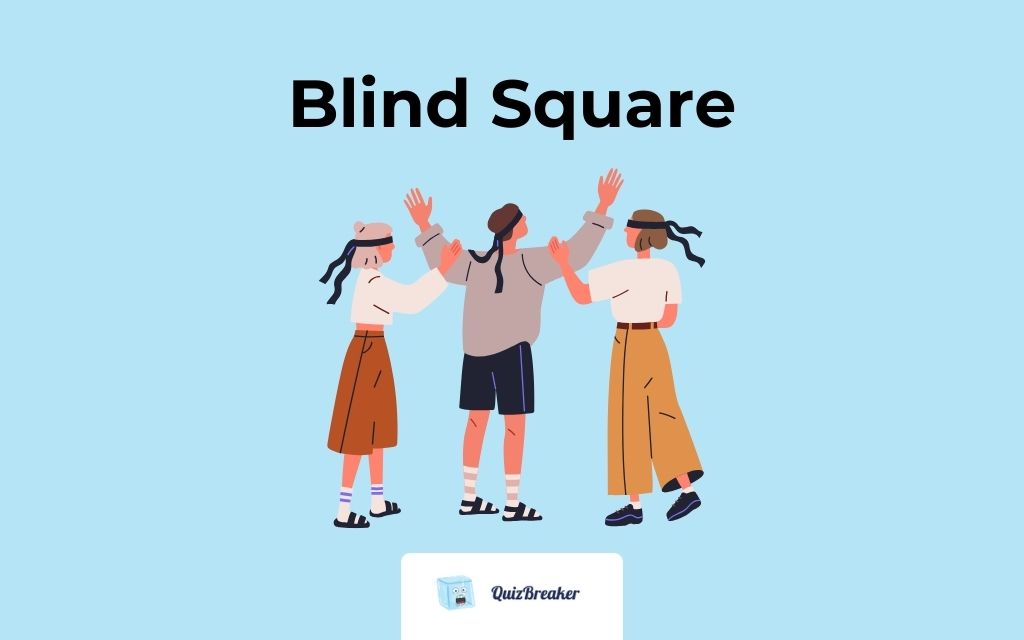
Objective: All participants have to do is form a square from the rope, whilst blindfolded.
Participants: 6 to 10
Duration: 25 minutes
Difficulty: Hard
Materials: Rope (about 20m) and a blindfold for each participant
This ice breaker is in our list of favourites because it produces results every single time it is used. It is fun, problem-solving focused and light-hearted.
Instructions
-
Give everyone around 15 minutes of planning time, in which no one can touch the rope.
-
Set the clock for 10 minutes and blindfold everyone.
-
Place the rope in the employees' hands and ask them to create a square.
-
Once they think they’ve completed the task they should lay the rope in the square shape on the floor.
-
Get everyone to take off their blindfold and see the shape they have created.
Tip: to make this game harder, don’t tie the rope into a circle at the start!
24. Building Challenges (Paper Tower, Marshmallow Challenge)
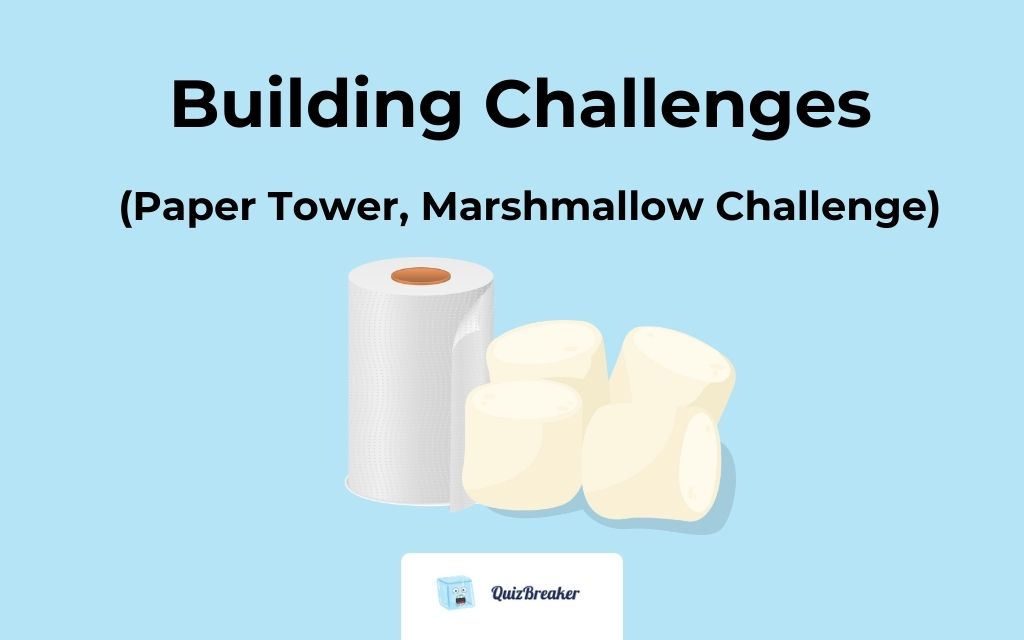
Objective: To get the employees to build a certain object within a time frame
Participants: 20 to 50
Duration: 20 minutes
Difficulty: Medium
Materials: Items of your choice to turn into objects (e.g., paper, marshmallows, straws)
This icebreaker game is one of the most popular and used games. They promote creativity, which empirical studies have found influences positive team outcomes; so this icebreaker will enhance the performance of your team.
Building challenges are also problem-solving focused, a skill that enhances team decision making, and thus teams effectiveness.
Instructions
There are many variations of building challenge icebreaker games, but they all follow a pattern similar to this:
-
Divide employees into small teams, we suggest no more than six per team.
-
Decide on what you want them to build with the unconventional material (e.g., who can build the tallest free standing tower from paper, who can create the London eye from straws.
-
With this, decide if they are allowed any other materials. For example, in the paper tower challenge, you may want to allow the teams to use sellotape to stick the paper together. Whereas the marshmallow challenge involves giving each group some dried spaghetti, string, tape and a marshmallow and groups have to build the tallest structure possible with the marshmallow on top.
-
Set a time limit, we suggest no longer than five minutes.
-
After the five minutes is up, get the teams to step away from their creation and decide who’s is the best (based on appearance, height, ability to stand on its own)
Personal Sharing Icebreaker Games
25. Unique & Shared
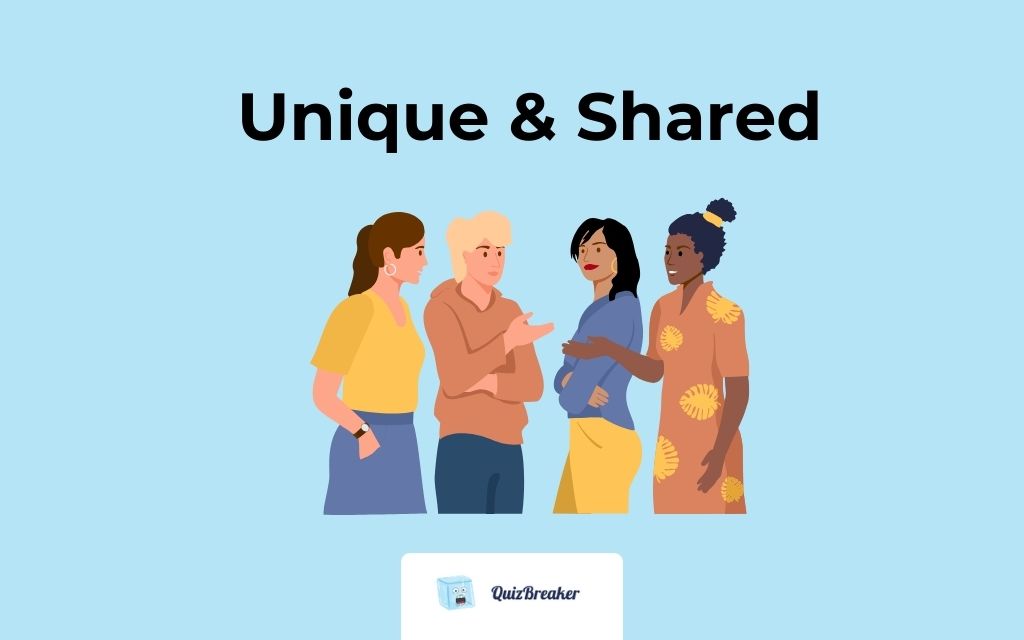
Objective: To get employees to discover what they have in common and to bring people together
Participants: 10 to 20
Duration: 20 to 30 minutes
Difficulty: Easy
Materials: None
We love this ice breaker idea because it brings your team together in a quick and easy way to get to know each other. It's also a great conversation starter for newly onboarded staff. ofrelatively new teams.
Essentially, the aim of the game is to get your employees to find out what characteristics they all share, and what ones are unique.
This is great because your team members will feel empowered if they feel like they offer the group something unique to the group, and studies have found that empowered employees are more productive.
Similarly, we love this ice breaker because it helps you to figure out what types of characteristics are in your team.
As research has found that teams possessing similar characteristics are more effective, it will be useful for you to figure out early on exactly what characteristics your team members have in common so you can use them to your advantage.
Instructions
-
Put employees into groups of 4-5 people.
-
Get them to go around the group and discover what they have in common.
-
To make the game extra fun and involving, get each participant to say why they think their unique characteristics make them well suited to the team and what this brings to the team.
26. Group Map
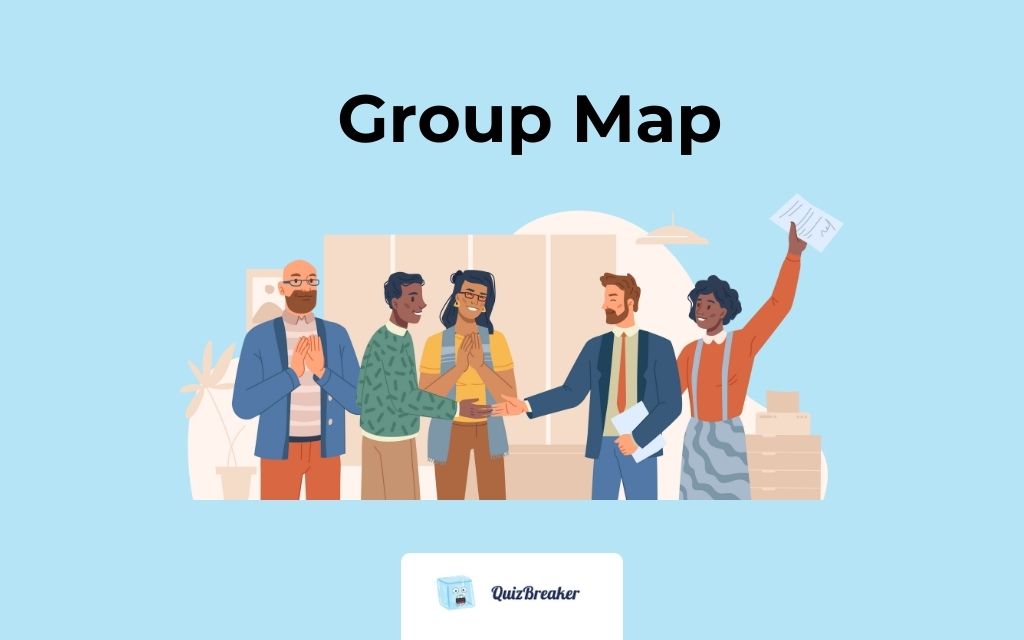
Objective: To get people to get to know where each other come from
Participants: 10 to 30
Duration: 10 to 20 minutes
Difficulty: Medium
Materials: None
The group map ice breaker comes in at a solid number 15 on our list of icebreaker games because it is an active game that encourages your team members to get to know each other’s backgrounds and a bit about their childhood values and stories.
Instructions
-
Get participants to imagine a map.
-
On this map, participants must stand where they grew up.
-
Go around the group and ask each participant to say where they are standing and what values they got from this place. To make it even longer, you could ask them to share a short story about their childhood.
27. Low Tech Social Networking
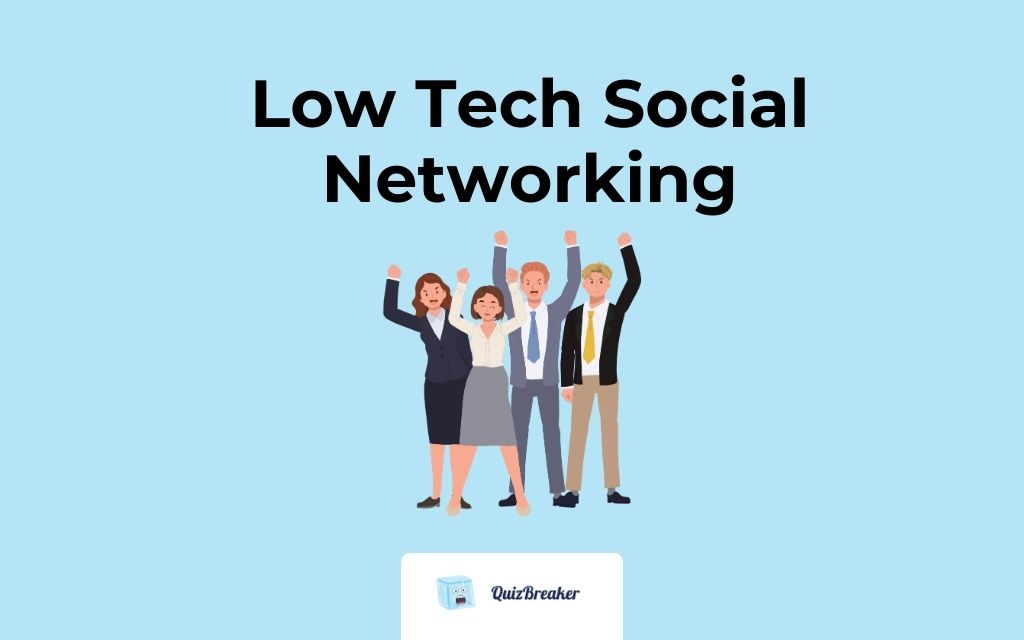
Objective: To introduce participants to each other when they don’t really know each other
Participants: 10 to 50
Duration: 25 to 30 minutes
Difficulty: Hard
Materials: 5 x 8 index card and a pen per participant
We love this game because it provides a visual way for participants to get to know each other.
By creating a mural-sized, visual network of their connections, team members can see visually how they relate to each other and find common connections to chat about.
Instructions
-
Get each participant to draw a picture of themselves.
-
Stick each participant's picture on a wall/whiteboard (anything that can be written on)!
-
Each participant takes it in turns to draw lines to the people they know.
28. Human Bingo
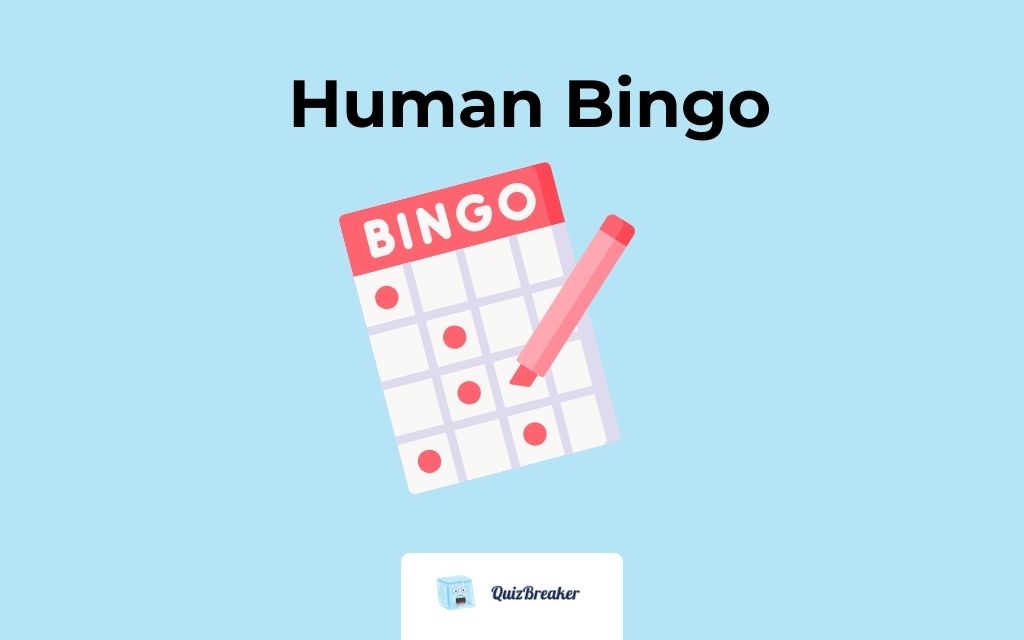
Objective: To get employees moving around the room and finding out traits about each other
Participants: 10 to 30
Duration: 35 minutes
Difficulty: Medium
Materials: Human Bingo Cards
If you’ve done your reading, you’ll have noticed that human bingo appears numerous times on our blog posts as one of our all-time favourite ice breakers.
We love it because it's fun, active and introduces new recruits to each other on a personal level to get to know each other, without being too intimate.
Instructions
-
Give each participant a bingo card, either homemade or found on the internet, and a pen.
-
Explain that the group has 30 minutes to mingle with each other. During this time, they should be introducing themselves to one and other and finding people who match the traits on the bingo card.
-
Once they have found the person with the correct trait, they must put the person’s name in the corresponding box, or have the person sign the appropriate square.
-
Just like a normal game of bingo, the clock continues to tick until the first person to fill five boxes across or down yells “Bingo”.
-
If you want the game to go on for a little longer, you could have multiple opportunities to win. For example, the first person to get a full horizontal line, the first to get a vertical line and then the first to get a full house. To involve employees even more in the game, perhaps ask them at the beginning what they think a completed game should be.
-
To make the game more exciting and motivating, have a prize (or prizes, if playing the longer game) ready to give the winners. In our opinion, a bottle of nice wine will do but you could always offer gift vouchers.
29. Lucky Penny

Objective: To get team members to tell stories about themselves
Participants: 5 to 20
Duration: 20 minutes
Difficulty: Easy
Materials: Some pennies (more pennies than participants) and a hat
Lucky Penny is a great icebreaker game for new hires because it gets everyone actively participating and sharing something interesting about themselves, without pushing them too far out of their comfort zone.
However, if you get the vibe that your team is shy, we suggest using the second variation of the game where you ask them to say historical fun facts.
This makes the game a bit more relaxed as the attention is taken away from the employee's personal life.
Instructions
-
Gather together some pennies and place them in a hat.
-
Get everyone to reach into the hat, grab a penny and share something meaningful that happened to them on the year the coin was minted (this could perhaps be funny if you have a younger team - make sure the coins were minted whilst they were born!).
-
Like previously mentioned, if your new team seems timider, replace the personal stories with historical facts that happened in that year.
30. Jenga Questions
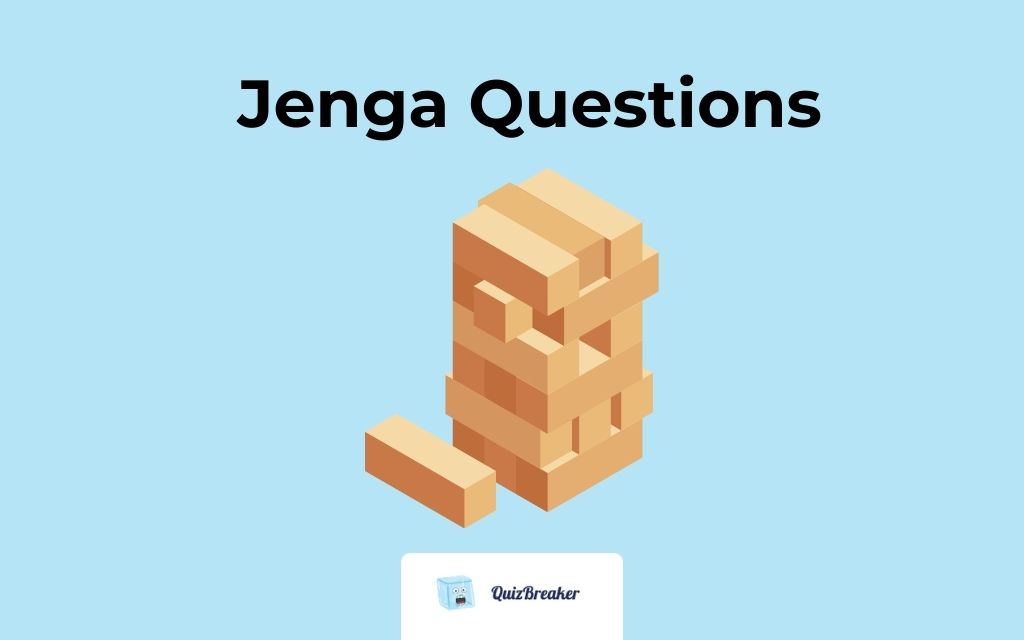
Objective: To get the team playing a fun game of Jenga, whilst answering questions
Participants: 5 to 10 people
Duration: 20 to 30 minutes
Difficulty: High
Materials: Jenga blocks and a pen to write on them
We like this game because it’s more exciting than just shoving a bunch of questions in a bowl and getting people to pick them out.
We personally feel that using the Jenga game gives the activity an interesting twist which makes it far more engaging.
This icebreaker is simple, yet effective and promotes a relaxed mindset to get everyone to share anecdotes about themselves.
Instructions
-
Write on each Jenga block a different question that employees will have to answer as they play through the game. For example, “what are your goals for this year?”, “where were you born?”, “what do you like most about this job?”.
-
The rules after this follow as a typical game of Jenga (we hope you know how to play!). Get each participant to pull out a Jenga block, without the tower falling down. Then they pull out the block, they must answer the question written on it.
31. Fun Questions
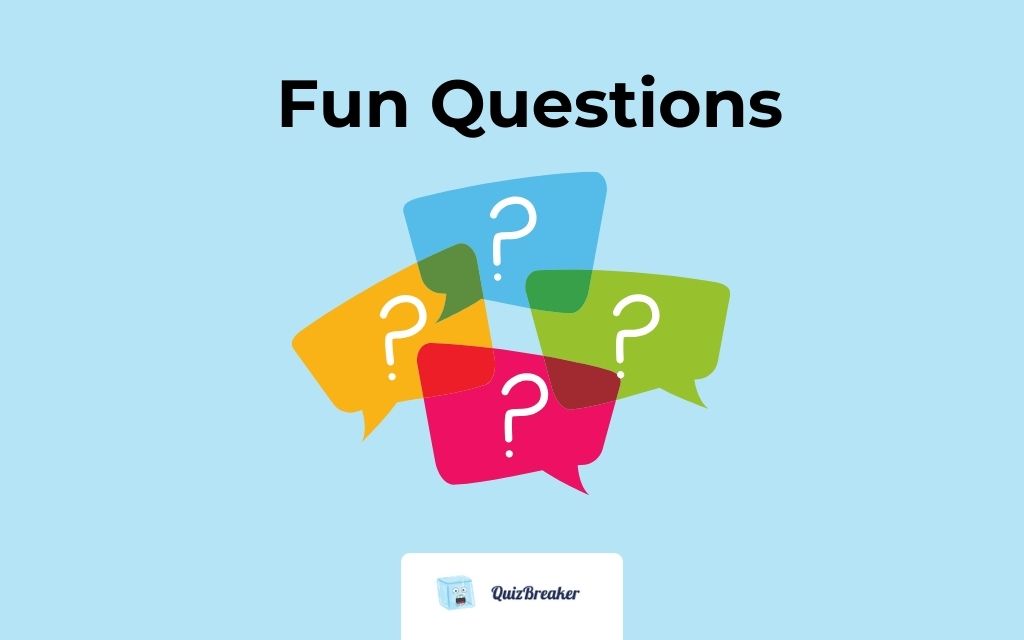
Objective: To get everyone to ask fun questions
Participants: 10 to 15
Duration: 20 minutes
Difficulty: Easy
Materials: None
Asking fun questions is an easy and effective way to break the ice, regardless of the situation.
Asking questions develops strong levels of trust and intimacy amongst teams, especially when the questions are downright silly.
This means that coworkers can learn a bit more about each other and start conversations that wouldn’t normally happen in the workplace.
Instructions
To be honest, the instructions are very simple.
Everyone sits in a circle and asks a silly question to the person to their left. The person on the left must answer the question and then ask a new question to the person to their left.
If your group is smaller, get everyone to answer everyone's question instead of going around the circle.
Top tip: We understand that it can be difficult to achieve this if you’re working in a remote team or if people find talking to each other in person to be difficult. The great news is that there is a very easy way to overcome this particular challenge. Using something like QuizBreaker you can create a fun weekly quiz that’s delivered to every team member via email.
This takes away much of the pressure that’s typically involved with running icebreaker games in person and is a fantastic way to bring everyone together regardless of where they’re located in the world.
32. Sharing Expectations
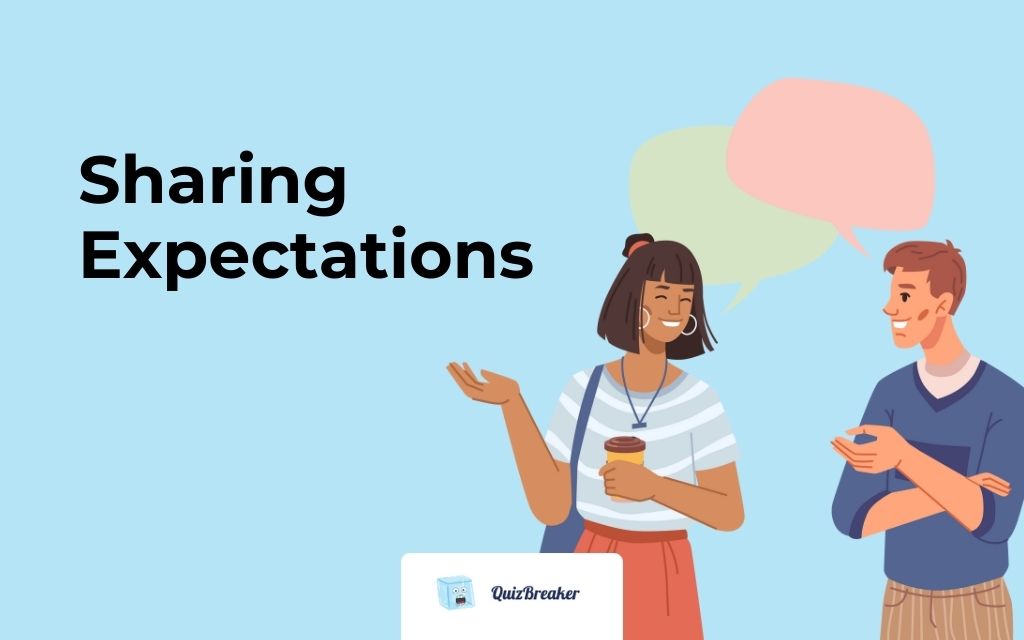
Objective: To understand what everyone expects from the team and the organisation
Participants: Up to 10 people
Duration: 10 minutes
Difficulty: Easy
Materials: A whiteboard and pen
In all honesty, the most straightforward way to kick off any meeting with a new team is to ask them what their expectations are.
If you know from day dot what people expect from you, what they hope to gain and how they want to do it, you can help them work towards these goals.
This ice breaker activity builds relationships between you and your team, helps you achieve goals and makes your team feel valued.
Instructions
The instructions are simple, ask your team members what they expect from you.
You can either get them to say it in front of everyone and then write it on a whiteboard.
Or, you can get them to write it down anonymously and you can write up your favourite ones for everyone to see.
One final suggestion is to do this in a one-to-one manner, where you pull everyone aside individually and ask them their expectations.
33. Two Truths and a Lie
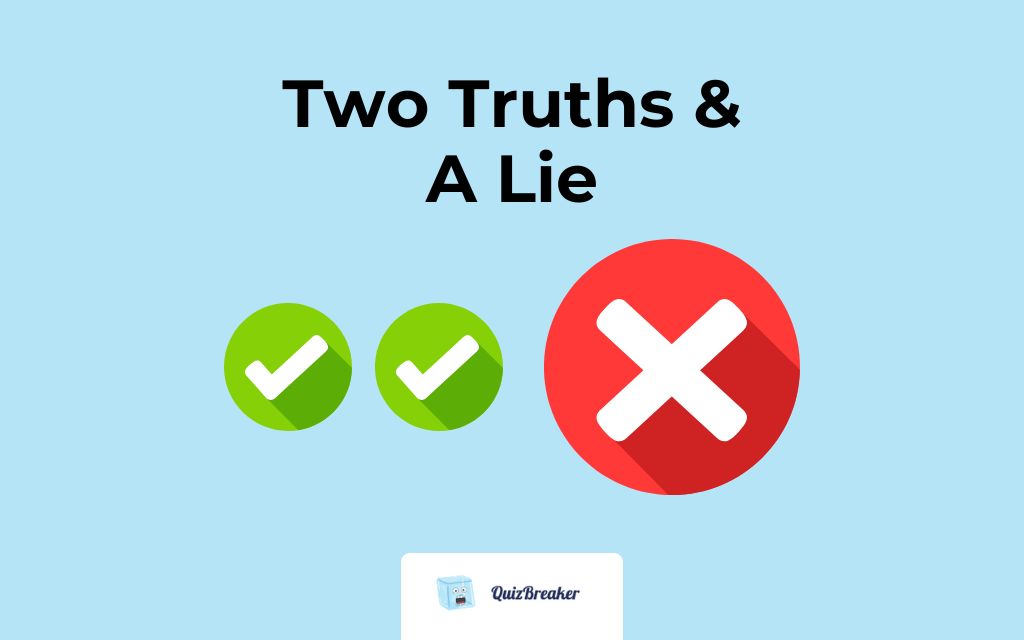
Objective: Learn new things about each other in a fun way
Participants: 4 to 25
Duration: 10 to 20 minutes
Difficulty: Easy
Materials: None required
We love two truths and a lie because it is a classic icebreaker game that can be used to get the conversation flowing and have some fun while you’re at it.
Instructions
-
Go around the room and get every employee to share two facts about themselves and one lie.
-
The rest of the group have to discuss which one they think is the lie, and then they vote.
-
Go around the room until every employee has had the chance to share their two truths and one lie.
A top tip for this game is to ensure that you don’t randomly spring this kind of icebreaker on people as some, especially those who consider themselves introverted or shy, find it distressing to suddenly be in the spotlight.
Sidestep this problem by giving everyone some notice that you’re going to be playing this game.
Besides giving people some time to prepare and be more creative with their answers, this team icebreaker also gives introverts time to mentally prepare for this type of activity.
The Right Way to Break the Ice
Before you dive headfirst into the ice, it is important to remember that icebreaking is only effective when carried out properly. To avoid bored eye rolls and sighs, it is critical that your icebreaking is engaging, accurate and fun.
1. Know your goal
Having a goal in any kind of team activity is really important, with research finding that having clear goals improves team effectiveness.
When deciding what icebreaker games to use, it is important to know what you’re working towards and what you want to achieve from your icebreaker session. If you just want to use icebreakers as a quick introduction, then don’t spend a whole day on icebreakers.
2. Consider everyone’s comfort zone
One of the biggest problems with icebreaker games is that the individual and their comfort zones are often ignored. This leads to employees feeling uncomfortable and not involving themselves in their activities properly, meaning they won’t get the best out of the ice breaking session.
3. Create a level playing field
Ice breakers are designed to break down social barriers and make all team members feel equal. Whilst playing fun icebreaker games, ignore the hierarchy and authority within your team and encourage everyone to interact.
Overall, we recommend doing these 10 things when breaking the ice:
-
Keep it short
-
Keep it light
-
Keep it encouraging
-
Keet it fun
-
Involve everyone
-
Make it upbeat
-
Encourage everyone
-
Keep it moving
-
Keep it simple
-
Keep doing it!
-
Get everyone to share personal details like their favorite things
Frequently Asked Questions
How do icebreakers boost work productivity?
Ice breaker games are a great way to start a meeting off. It set's a fun and informal precedent to get everyone feeling relaxed. It gives everyone a moment in their day to refresh and feel energized. Remember to change up the games, and try something new every meeting until you find the right activity for your team. Check out our favorite icebreaker questions for some inspiration.
How long should ice breaker games last?
Icebreaker games shouldn't last too long, as you want to keep participants engaged. Most of the activities on the list are between 5 to 30 minutes
What are quick icebreaker games?
We got you covered and curated the best 5-minute activities that will have your team feeling closer in no time. Try our top 5- minute group team building games.
Can you use these games in a classroom setting?
Yes, of course! They are great for all ages, just make sure they fit the age group you are targeting as some instructions can be a bit more complicated.
Conclusion
So, there you have it… a list of the best icebreaker games that you can try with your own team!
Other classic ice breaker ideas include the marshmallow challenge, virtual scavenger hunt, speed networking, would you rather, toilet paper reconstruction, mad libs, no smiling, personality quizzes, desert island, theme song & speed dating. Look these fun icebreakers up if you need more ideas!


